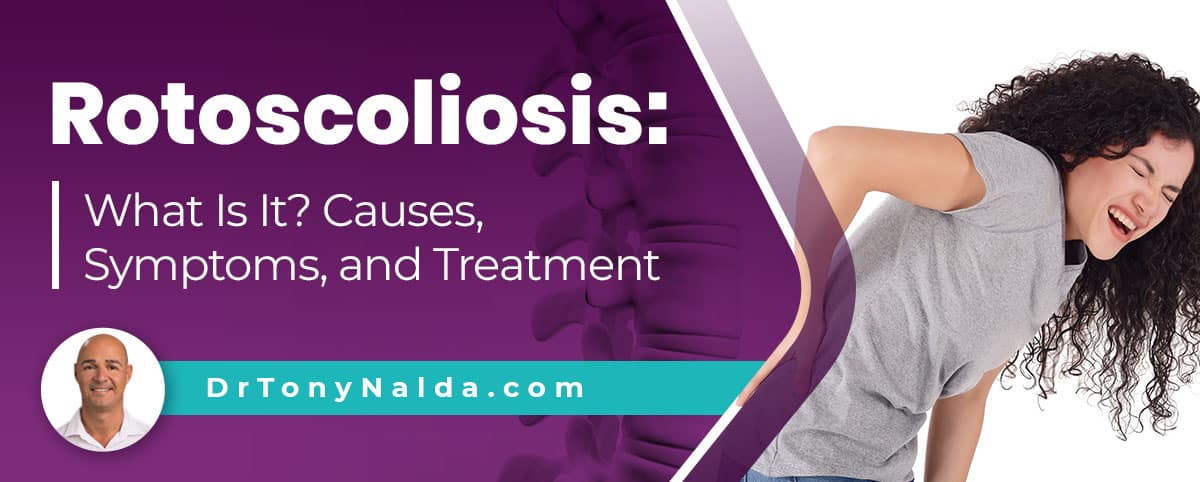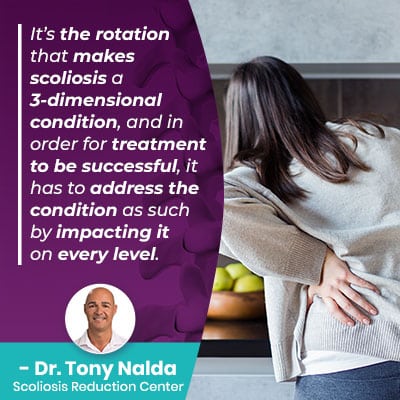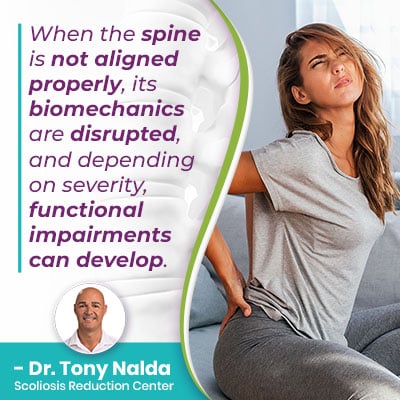Rotoscoliosis: What Is It? Causes, Symptoms, and Treatment

Scoliosis is a 3-dimensional condition, and this is due to its rotational component. Not only does a scoliotic spine bend unnaturally to the side, it also twists from back to front, front to back, and this increases the uneven forces scoliosis introduces to the body and related postural deviation.
In order to reach a diagnosis of scoliosis, certain parameters have to be met; there has to be an unnatural sideways spinal curve with rotation and a minimum Cobb angle measurement of 10 degrees. Rotoscoliosis is scoliosis with a significant amount of rotation.
When scoliosis is first diagnosed, it’s further classified based on a number of key variables that can involve confusing medical terms. Let’s start by breaking down the term rotoscoliosis.
Table of Contents
What is Rotoscoliosis?
Scoliosis involves the development of an unnatural sideways spinal curve, but in order for it to be classified as true structural scoliosis, it has to include a rotational component, meaning the spine twists as well as bends.
 It’s the rotation that makes scoliosis a 3-dimensional condition, and in order for treatment to be successful, it has to address the condition as such by impacting it on every level.
It’s the rotation that makes scoliosis a 3-dimensional condition, and in order for treatment to be successful, it has to address the condition as such by impacting it on every level.
The term rotoscoliosis, as you can likely guess, comes from the word rotation.
While all forms of structural scoliosis include rotation, if the specific term rotoscoliosis makes its way into a diagnosis, this means there is an above-average amount of rotation, meaning the spine has a severe twist to it.
An excessive amount of rotation makes the unnatural spinal curve more complex and increases the uneven forces the condition introduces to the body, which means that related symptoms, like postural deviation, are likely to be more noticeable.
So now that we have defined rotoscoliosis, what are some of its common symptoms?
Rotoscoliosis Symptoms
The spine consists of vertebrae stacked on top of one another in a straight and neutral alignment, but when scoliosis comes into play, the vertebrae in the curve, particularly at its apex, are tilted, and this causes the spine to become misaligned.
When the spine is not aligned properly, its biomechanics are disrupted, and depending on severity, functional impairments can develop.
Severity is determined by a patient’s Cobb angle measurement, and Cobb angle is known as the orthopedic gold standard in the assessment of scoliosis. It involves drawing intersecting lines from the tops and bottoms of the curve’s most-tilted vertebrae, and the resulting angle is expressed in degrees and places conditions on a severity scale:
- Mild scoliosis: Cobb angle measurement of between 10 and 25 degrees
- Moderate scoliosis: Cobb angle measurement of between 25 and 40 degrees
- Severe scoliosis: Cobb angle measurement of 40+ degrees
- Very-severe scoliosis: Cobb angle measurement of 80+ degrees
The higher the Cobb angle, the more out of alignment the spine is, and the more extreme related symptoms are going to be.
As you can see from the wide range of Cobb angle measurements, scoliosis ranges greatly in severity, and the rotational component can also vary from one patient to the next.
An excessive rotational component in rotoscoliosis means the spine is not just being pulled to the side but also twisting, increasing the spinal misalignment and related symptoms.
Condition severity and the degree of rotation factor into how a patient is likely to experience their condition, and a patient’s rate of progression also plays a role.
While each condition is unique, some common visual symptoms of rotoscoliosis include:
- Uneven shoulders
- Uneven shoulder blades
- The development of a rib arch (directly related to the rotational component)
- An uneven waist
- Arms and legs that appear to hang at different lengths
- Ill-fitting clothing
- Changes to balance, coordination, and gait
Now that we’ve addressed some common symptoms of rotoscoliosis, let’s talk about its causes.
Rotoscoliosis Causes
Rotoscoliosis causes are the same as general causes of scoliosis, with some being known and others unknown.
The most prevalent condition type is adolescent idiopathic scoliosis (AIS), diagnosed between the age of 10 and 18.
The idiopathic designation means that it’s not clearly associated with a single-known cause and is, instead, considered to be multifactorial: caused by multiple variables that can vary from one patient to the next.
 The majority of scoliosis cases, 80 percent, are classified as idiopathic, and the remaining 20 percent are associated with known causes: neuromuscular, congenital, degenerative, and traumatic.
The majority of scoliosis cases, 80 percent, are classified as idiopathic, and the remaining 20 percent are associated with known causes: neuromuscular, congenital, degenerative, and traumatic.
In cases of neuromuscular scoliosis, the scoliosis develops as a secondary complication of a serious neuromuscular condition such as cerebral palsy, muscular dystrophy, and spina bifida, to name a few.
These conditions involve a disconnect between the brain and the muscles that support the spine, impairing the spine’s ability to maintain its natural/healthy curves and alignment.
In cases of congenital scoliosis, the condition develops in utero due to a malformation within the spine itself; the condition is rare, affecting approximately 1 in 10,000, and infants are born with it.
Healthy vertebrae are rectangular in shape, which allows them to be stacked on top of one another in a straight and neutral alignment.
Congenital scoliosis can involve a malformed vertebra that is more triangular in shape, and that can shift the position of the spine, allowing it to become misaligned.
In addition, the failure of vertebrae to form into separate and distinct bones, becoming fused together instead (bony bar), can also cause congenital scoliosis.
Degenerative scoliosis involves natural age-related spinal degeneration that affects older adults.
It’s most common in adults over the age of 40, and the cumulative effect of certain lifestyle choices can also play a role in the level and rate of spinal degeneration: carrying excess weight, leading a sedentary life, chronic poor posture, and repeatedly lifting heavy objects incorrectly and straining the spine.
Women are more likely to develop degenerative scoliosis than men due to hormone/bone density changes related to menopause.
In most cases of spinal degeneration, the intervertebral discs are the first spinal structures to deteriorate. As they provide the spine with structure, cushioning between adjacent vertebrae, and act as the spine’s shock absorbers, disc degeneration is at the root of many spinal conditions/issues.
A disc that changes shape due to deterioration can cause the spine to shift out of alignment because adjacent vertebral bodies attach to each end of the disc in between.
Disc desiccation, degenerative disc disease, bulging, or herniated discs can all contribute to a misaligned spine and the development of degenerative scoliosis.
In cases of traumatic scoliosis, the spine has experienced a trauma that has injured the spine, such as in a fall or car accident, and injuries like compression fractures can weaken the bones of the spine and compromise its ability to stay aligned.
In addition, the presence of spinal tumors can also apply enough uneven pressure to the spine that it can force it out of alignment and lead to the development of a scoliotic curve.
So now that we’ve defined rotoscoliosis and explored some of its symptoms and causes let’s talk about treatment and what to do once a diagnosis is reached.
Rotoscoliosis Treatment
When it comes to the treatment of rotoscoliosis, regardless of causation, the best time to start treatment is always now.
Remember, as a progressive condition, where scoliosis is at the time of diagnosis is not indicative of where it will stay; only proactive treatment can counteract the condition’s progressive nature and stop a mild diagnosis from becoming moderate, severe, or very severe.
Here at the Scoliosis Reduction Center, patients benefit from a proactive conservative chiropractic-centered treatment approach that works towards preserving as much natural spinal function as possible.
I integrate multiple condition-specific forms of treatment into a treatment plan so it can be fully customized to address key patient/condition variables and impact conditions on every level.
Through a series of chiropractic techniques and adjustments, I can work towards reducing the curve on a structural level, which is the focus of treatment. Once I see those structural changes, I can shift the focus to increasing core strength so the spine is optimally supported and rehabilitating/stabilizing the spine.
When bracing is needed, I opt for the ScoliBrace because of its corrective potential, and when combined, these distinct forms of treatment complement one another for increased chances of treatment success.
Conclusion
So what is rotoscoliosis? Rotoscoliosis is an unnatural sideways spinal curve with a Cobb angle measurement of 10+ degrees and a significant degree of rotation.
In order for scoliosis to be considered structural, there has to be a rotational component, so while all scoliosis includes rotation, rotoscoliosis indicates a higher-than-average amount of rotation.
Because rotation means the spine also twists, the more rotation there is, the more uneven forces there are being introduced to the body, and the more postural deviation there is likely to be as a result.
In children and adolescents, the main symptom of rotoscoliosis are postural changes that disrupt the body’s overall symmetry; the main symptom in adults is pain, which will increase with the degree of rotation.
Postural changes include uneven shoulders and hips, and pain can be localized back, or radicular pain felt throughout the body due to compression of the spine and its surrounding nerves.
Here at the Center, I address rotoscoliosis proactively because, as a progressive condition, I want to start treatment while scoliosis is mild, when it’s far less complex to treat, and there are fewer limits to what we can achieve.
Dr. Tony Nalda
DOCTOR OF CHIROPRACTIC
After receiving an undergraduate degree in psychology and his Doctorate of Chiropractic from Life University, Dr. Nalda settled in Celebration, Florida and proceeded to build one of Central Florida’s most successful chiropractic clinics.
His experience with patients suffering from scoliosis, and the confusion and frustration they faced, led him to seek a specialty in scoliosis care. In 2006 he completed his Intensive Care Certification from CLEAR Institute, a leading scoliosis educational and certification center.
About Dr. Tony Nalda
 Ready to explore scoliosis treatment? Contact Us Now
Ready to explore scoliosis treatment? Contact Us Now





